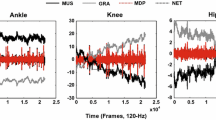Abstract
The degrees of freedom problem is often posed by asking which of the many possible degrees of freedom does the nervous system control? By implication, other degrees of freedom are not controlled. We give an operational meaning to ”controlled” and ”uncontrolled” and describe a method of analysis through which hypotheses about controlled and uncontrolled degrees of freedom can be tested. In this conception, control refers to stabilization, so that lack of control implies reduced stability. The method was used to analyze an experiment on the sit-to-stand transition. By testing different hypotheses about the controlled variables, we systematically approximated the structure of control in joint space. We found that, for the task of sit-to-stand, the position of the center of mass in the sagittal plane was controlled. The horizontal head position and the position of the hand were controlled less stably, while vertical head position appears to be no more controlled than joint motions.
Similar content being viewed by others
Author information
Authors and Affiliations
Additional information
Received: 24 June 1998 / Accepted: 20 December 1998
Rights and permissions
About this article
Cite this article
Scholz, J., Schöner, G. The uncontrolled manifold concept: identifying control variables for a functional task. Exp Brain Res 126, 289–306 (1999). https://doi.org/10.1007/s002210050738
Issue Date:
DOI: https://doi.org/10.1007/s002210050738




